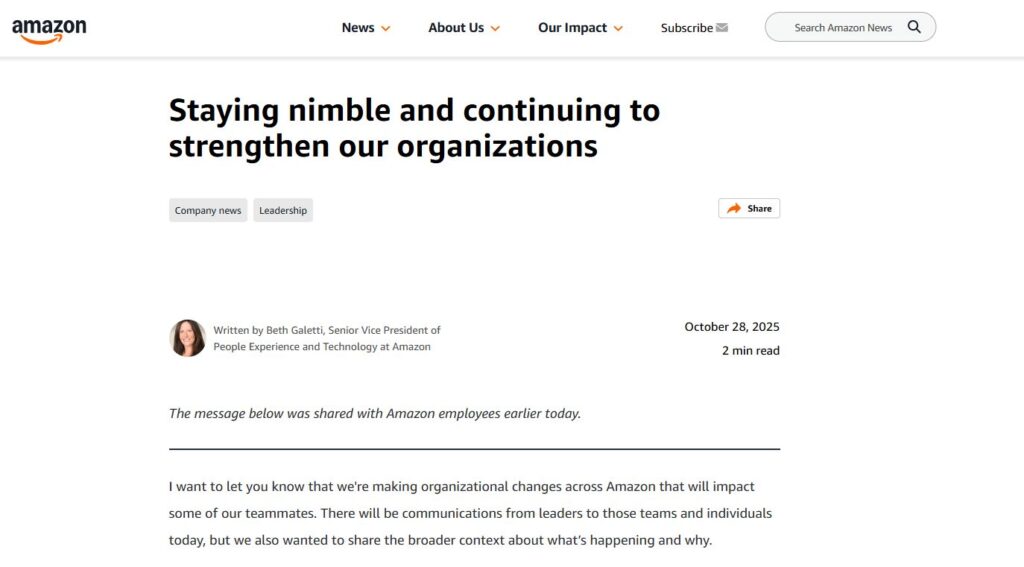Amazon announced it will reduce about 14,000 corporate roles as part of a broader restructuring designed to “reduce layers, increase ownership, and move faster.” The decision reflects more than just cost management, it’s a signal that AI and organizational agility are becoming inseparable in modern corporate strategy.
Amazon’s leadership framed the move as a structural optimization rather than a financial necessity, emphasizing continued investment in growth areas like AI, logistics, and cloud computing.
TL;DR
Amazon’s 14,000 job cuts are less about downsizing and more about redesigning.
- AI and organizational agility are now core competitive levers.
- The goal is a flatter, faster structure that pushes authority to the edge.
- Companies that de-layer early will adapt better to AI-driven productivity shifts.
AI and Organizational Agility at Amazon
Amazon’s restructuring highlights a truth many companies are now confronting: organizational agility determines how effectively AI can be adopted.
Flattening layers isn’t just about efficiency, it’s about speed. The faster decisions can be made, the faster AI-driven insights can be acted upon. As Harvard Business Review notes, agile structures are becoming essential to “capture value from AI systems that operate in real time” (Harvard Business Review).
By reducing bureaucracy, Amazon aims to operate more like a network of small, empowered teams rather than a rigid hierarchy. Each node in that network can experiment, learn, and scale innovations faster.
AI and Organizational Agility Require Structural Change
This restructuring is a strategic redesign. Amazon called the effort part of its plan to operate “like the world’s largest startup.”
That phrase matters. Startups are built for iteration and rapid feedback loops. Amazon’s reorganization will “push authority to the edge” where teams closest to customers and data can make faster calls.
By cutting layers, Amazon is betting it can move faster than competitors who rely on slower, top-heavy decision chains.
AI and Organizational Agility Depend on Empowerment
The next frontier of corporate productivity is distributed decision-making.
Smaller teams, empowered to make quick calls based on real-time AI insights, can deliver compounding efficiency. Companies with flatter hierarchies are adopting AI faster and reporting stronger innovation pipelines.
Amazon’s approach suggests that leadership in the age of AI is no longer about control, it’s about clarity, empowerment, and trust at the edges of the organization.
AI and Organizational Agility: The Broader Lesson
Amazon’s restructuring is one of the first visible examples of AI’s indirect impact on the labor market. Not through outright replacement, but through de-layering, where the organizational pyramid compresses so decisions can travel faster.
True transformation doesn’t just come from deploying new technology; it comes from rethinking structures, cultures, and mindsets to match the speed of AI systems. The real bottleneck is the org chart.
FAQs
Why is Amazon cutting 14,000 jobs?
To streamline operations and create a flatter structure that improves agility and decision speed.
Is this move AI-related?
Yes. Amazon’s leadership explicitly linked the restructuring to preparing for an AI-driven future.
Will Amazon continue hiring?
Yes. The company said it will keep hiring in growth areas like AI, AWS, and logistics technology.
What does de-layering mean for employees?
It increases autonomy for smaller teams and shifts focus toward faster, data-driven decisions.
Conclusion
AI and organizational agility are now core parts of business strategy, not just buzzwords. Amazon’s move to flatten its corporate structure shows what adaptation looks like in practice: fewer layers, faster feedback loops, and empowered teams operating close to the data.
The companies that follow this path, redesigning around agility rather than hierarchy, won’t just move faster. They’ll think faster, learn faster, and lead the next era of AI-powered growth.
Related content you might also like:
- Agentic AI: Unlocking Organizational Transformation
- Supply Chain Agility: Lessons from Mattel’s Global Trade Strategy
- Monetizing Digital Structure
- Tariff Resilience Strategies: Lessons from TJX’s Agile Playbook
- on Kindle Pricing Part II



